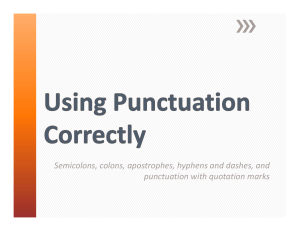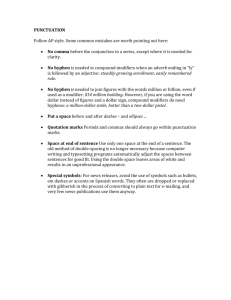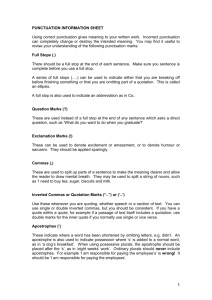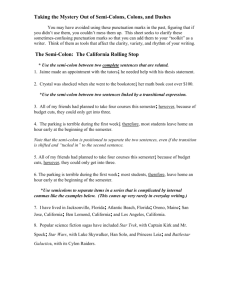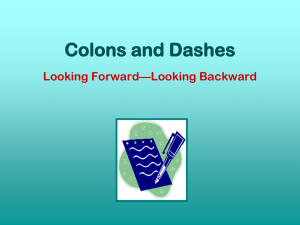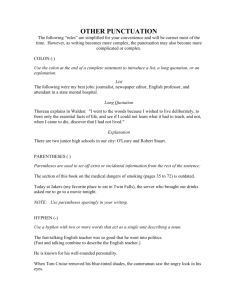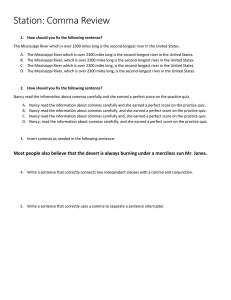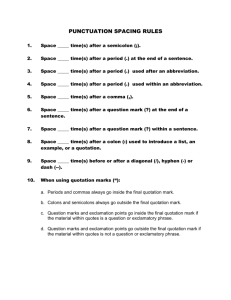Semicolons, colons, apostrophes, hyphens and dashes, and
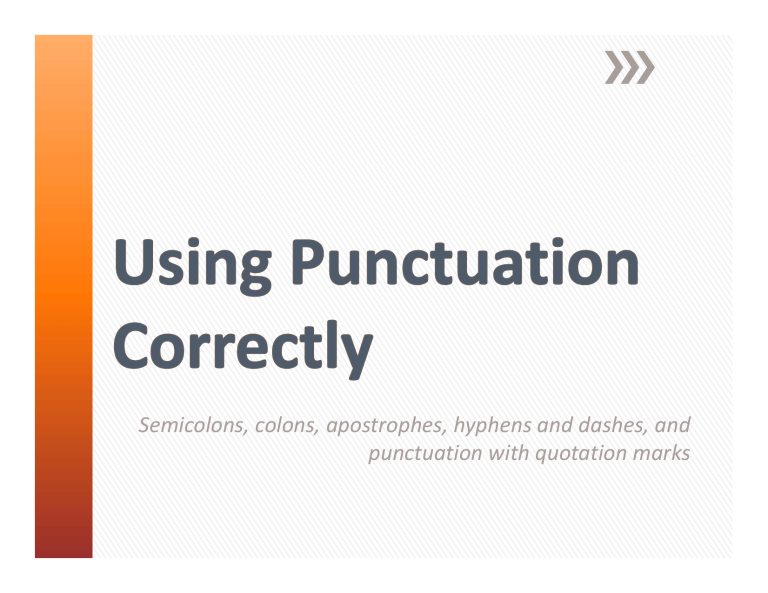
Semicolons, colons, apostrophes, hyphens and dashes, and punctuation with quotation marks
Overview
1. Semicolons (;)
2. Colons (:)
3. Apostrophes (‘)
4. Hyphens and dashes ( ‐ and –)
5. Ellipses (…)
6.
Punctuation combined with quotation marks
7.
Single or double quotation marks?
» A semicolon connects independent clauses – parts of a sentence that could stand as their own sentences:
He loved that car ; it was his greatest treasure.
Where would you put the period or semicolon in the sentence below?
In Western films, dark hats often represent bad or evil characters a white hat does just the opposite.
“In Western films, dark hats often represent bad or evil characters ; a white hat does just the opposite.”
Periods (.) and semicolons (;) can be used interchangeably!
» You should always use a semicolon in these two situations…
1. … between items in a series where commas are used for each item :
Science fiction includes Star Trek , with Mr.
Spock ;
Battlestar Galactica , with its Cylons ; and Star Wars , with
Luke Skywalker and Darth Vader.
2. … between independent clauses (often before transitions words*: accordingly, however, hence, … ), especially if the two sentences “feel related”:
Mushrooms grow very quickly ; in fact, after a good rain, it takes only a few hours and you start picking them.
Even baby giraffes are tall ; their average height is six feet!
*ask for a list of transition words at the Writing Center!
» IMPORTANT: DO NOT USE THE SEMICOLON AS A
COLON!!
Wrong: Some
celebrities
can
barely
even
make
a
meal
for
themselves
;
the
Kardashians,
The Jersey Shore ’s
Snooki,
and
Lindsey
Lohan.
Correct: …
» IMPORTANT: DO NOT USE THE SEMICOLON AS A
COLON!!
Wrong: …
Correct: Some
celebrities
can
barely
make
food
or
take
of
themselves
:
the
Kardashians,
The Jersey Shore ’s
Snooki,
and
Lindsey
Lohan.
» A colon is used to introduce information , specifically after a “complete sentence” (=independent clause) phrase that introduces a quotation:
The author always disliked his critics : “If they can’t write, they become critics!”
The list that follows the colon is not needed to complete the sentence:
My roommate wants to buy a car, and he has a lot of brands to choose from : Toyota, Ford, VW, and more.
Rule: Use a colon before a list if you could replace it with a period!
BUT: Use a comma for fragments introducing quotations:
The author complains , “If they can’t write, they become critics!”
Practice: comma, colon, or nothing before the quote?
Liliana bought (colon?) milk, cereal, and sugar.
Chris is taking two science courses (colon?) Physics 101 and Biology 201.
For the trip, be sure to bring items such as (colon?) clothes, money, and lots of money.
Answer:
Liliana bought milk, cereal, and sugar.
Chris is taking two science courses : Physics 101 and
Biology 201.
For the trip, be sure to bring items such as clothes, tools, and lots of money.
For colons introducing lists and quotations, remember:
Complete
sentence
+
colon
=
correct
Fragment
+
colon
=
incorrect
» Use the apostrophes only to show possession
(somebody owns something) and for contractions
(combining two words):
John ’ s dog will quickly eat Mary ’ s cat.
Lois ’ s sister will visit tomorrow.
Extra rule 1: If the noun (the “owner”) is plural and ends in –s, add only one apostrophe:
The diplomats ’ briefcases were searched.
The papers’ thesis statements were good.
Extra rule 2: In the case of multiple nouns/“owners,”, use
‐ ‘s with the last noun only to show joint possession:
Have you seen David and Alena ’ s new camper?
Make all nouns possessive to show individual possession:
Jack ’ s and Berta ’ s expectations of marriage were very different.
Outside of academic writing, use the apostrophe for contractions :
It is a shame that he will leave soon.
It ’ s a shame…
Are they not hungry after the long walk?
Aren ’ t they…
BUT: Avoid ALL contractions in academic or formal writing!
» Hyphens are used to combine two words into a single new one; a dash – double the length of a hyphen – shows a break or interruption of thought between sentence parts.
(“hyphens connect words, dashes separate groups of words”)
The high ‐ energy music show – which I attended last year – was a wonderful experience.
There are 4 situations in which the hyphen is used to combine words…
1. Use a hyphen when two words are used together as an adjective before the noun :
The teacher gave Toshiko a newspaper ‐ wrapped fish and a seashell.
Dr.
Jill Stein is not a well ‐ known presidential candidate.
Can you believe that she bought first ‐ class tickets?
But, do not use a hyphen if the same compounds word occurs after the noun it describes:
This presidential candidate is not well known.
Their hotel was often described as first rate.
2.
Use a hyphen for the prefixes self ‐ , quasi ‐ , all ‐ , elect ‐ , and ex ‐ (meaning “formerly”):
Her ex ‐ husband often expressed anti ‐ American ideas.
This organization supports self ‐ help projects that support low ‐ income families.
3.
Use a hyphen for written ‐ out numbers* (but not before/after category numbers like hundred , thousand , or million ) and fractions :
She was widely believed to be one hundred twenty ‐ two years old.
One ‐ fourth of his income went to childcare expenses.
*Remember: numbers smaller than 10 should be spelled out!
4.
Use a hyphen to avoid misreading, especially if the prefix would result in a double letter, or to avoid misreading:
James and Daniel are co ‐ owners of the restaurant.
The film was praised for its re ‐ creation of nineteenth ‐ century London.
What is the difference here?
Bicycling is my favorite form of recreation.
Now, let’s “dash on”…
» A dash signals an interruption or a break in thought – similar to a comma!
Dashes set off text that you want to stress or emphasize.
Use dashes …
1.
… with appositives (nouns that follow other nouns to describe them):
James – a pretty clever fellow – won the contest easily.
2.
… to set off emphasized information :
Everything that was broken – from the cracked window to the worn ‐ out carpet – was blamed on the dog.
3.
… to introduce a list or restatement :
Lately, Peter has been making changes in his life – reading more books and exercising more regularly.
The difference between commas, parenthesis, and dashes (in your handout)
Matt told his best friend , Sharon's sister , that he wants to work with you.
Commas are used to set off non– essential text that is closely related to the rest of the sentence.
This belief ( the incarnation ) is central to the Christian faith.
Parentheses are used as a reminder or to add information that is interesting but not critical to the meaning of the sentence.
My memories of my grandmother — and they are some of my strongest childhood memories — inspire me to always be patient and kind.
Dashes are used to interrupt the current thought and to emphasize the interrupting text .
When typing on a computer, you make a dash by typing two short dashes ( ‐‐ ) between two words—no spaces.
AutoCorrect will do the rest for you.
Note 1: Generally, you should not use spaces before and after hyphens or dashes – though certainly genres of writing (newspaper, electronic media, AP ‐ style) will use a space.
If in doubt, ask your instructor!
Note 2: Use dashes sparingly .
They are most effective when you use them no more than a couple times per page.
» Ellipses are used to indicate missing or omitted material , but ONLY for quoted material!
1. Use an ellipses to show deleted words :
Smith (2012) acknowledges that treatment for autism is expensive: “Sensory therapy ...
can cost up to $200 per hour.”
(3 dots)
2.
Use an ellipses to show deleted sentences :
Jackson, a researcher with the CDC, explained: “AIDS is still a massive problem ….
It is a pressing health issue.”
(4 dots)
(Do not use ellipses at the beginning of quoted material, but use them at the end of sentences (MLA only).)
» Punctuation follows special rules when used with quotations marks – some make sense, others are arbitrary.
All of the rules can be summed up in the
“Rule of Two”!
Two punctuation marks (commas and periods) go inside the quotation marks, two punctuation marks (colons and semicolons) go outside, and two others (question and exclamation marks) can go either place, depending on the meaning of the sentence.
Two go inside:
Period: He explained, “Commas are tricky business .
”
Comma: “Commas are tricky business , ” he explained.
Two go outside:
Semicolon: “This is not an easy topic” ; however, we all understood it immediately.
Colon: He often used good examples : “Cows love to eat grass.”
Two can go either place:
Either the question/ exclamation mark are part of the quote or part of the sentence itself…
Two can go either place:
Exclamation mark: I want to hear the song “Forever
Young” !
BUT: Someone yelled, “Help !
”
Question mark: She asked me, “Do you like jazz ?
”
BUT: What don’t you like about the song “Forever
Young” ?
Ask yourself: “If I leave the quoted material by itself, would it need the question or exclamation mark?” If so, then leave it inside the quotation marks.
